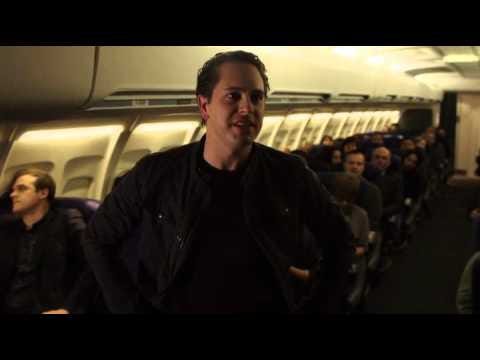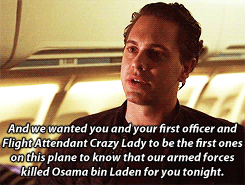There’s a clip from The Newsroom that makes its way through Twitter every couple months in which a news anchor “reports the news” of Osama Bin Laden’s death to the pilot on board an airplane. The scene is an ode to the utter unseriousness of Aaron Sorkin, a running gag picking at the absurdity of a showrunner who was once given credit for a “creative revolution” in television. Sorkin worked with a team of experts and former White House staffers to mimic the inner workings of the executive wing for The West Wing, and I’m convinced by the time he moved on to portraying the ins and outs of broadcast news in 2012 with The Newsroom, he said, “Fuck it, I watch CNN. I know how this shit works.”
If you haven’t seen the airplane scene, this is how it goes. Thomas Sadoski’s Don Keefer, Olivia Munn’s Sloan Sabbith and a pre-Stranger Things baby David Harbour playing Elliot Hirsch are all anchors within the fictional Atlantis Cable News (ACN) channel. They’re stuck on a plane that’s been stalled on the tarmac because of vague reasons of national security when they catch wind from their news team that President Barack Obama is going to announce Osama Bin Laden has been killed. The journalists are anxious to return to the newsroom. And for some reason, everyone is panicking about why the plane is being stalled, instead of just putting their headphones on and dissociating like I do every time my plane circles the tarmac at JFK.
To calm the agitated passengers, Don gets up and tries to assure everyone that there hasn’t been some kind of attack. The flight attendant tells him to sit down as is her right and he pulls a Karen and demands to speak to the pilot. When the pilot comes out, Don is suddenly overcome with patriotism looking at the stripes on the shoulders of this man’s little pilot uniform, as if they indicate he had some kind of military experience, which I looked it up and they mean no such thing! I guess he’s thinking about 9/11, either way it is corny as all get-out. But Don is humbled in the presence of this man who has a job and he says to him “Captain, my name is Don Keefer, we work for Atlantis Cable News and we wanted you and your first officer and flight attendant crazy lady to be the first ones on this plane to know that our armed forces killed Osama Bin Laden for you tonight.” The pilots shake hands like they played a role in this murder plot, Olivia Munn does some incredible face acting, one woman in the corner of the shot looks out the window not paying any mind to this nonsense as I would have done, and Don looks very self assured. He turns to David Harbour all proud and says, with his hands on his hips, “We reported the news.”
It’s a scene I think about at least once a week.
My friend texts the group chat “is it cold enough outside for a sweater?” I reply, “yes.” We reported the news.
A random girly at Union Hall asks me where the restroom is and I tell her it’s down the stairs to the right. We reported the news.
My mom calls, wondering if I’m quarantined in my home because she read somewhere that there are floods and fires and poisonous mosquitoes in New York and I tell her maybe that’s happening somewhere but not in Ridgewood, Queens. We reported the news.
There’s something to be said about the disillusionment of Americans in the last decade when you compare the 2012 YouTube comments under this Newsroom clip, which say the episode made them cry, with the more recent ones, which deem this the greatest piece of unintentional comedy since Jessica Simpson asked if tuna was chicken or fish. There’s absurdity to be found in every crevice of these three minutes of television, but the core of its hilarity is the idea that what Don did, reporting the news, meant anything. Now we know that killing Osama Bin Laden was a small win that would garner the U.S. military years of goodwill to distract from all the torture and war crimes the CIA carried out in response to the 9/11 attacks. This self aggrandizing pat on the back is laughable in the face of the 300,000 Iraqi civilians who died in a war of opportunity.
But there’s also absurdity in this statement itself: “We reported the news.” Is that what he did? If we boil journalism down to its simplest form, sure. Don had information the pilot didn’t have, and he shared it. This would describe a New York Times article. It would also describe an MTA worker’s muffled voice sputtering out of an intercom to tell us the M train is not running past 57th street.
In Don’s definition, anyone can be a reporter. And at that time, on the heels of the Arab Spring, the Occupy movement, and the peak of Twitter, anyone with a smartphone could be. There was talk of a new wave of journalism without all the gatekeeping, where anyone on the ground could tweet a picture or a video and the world could see it and take stock. It was a democratized movement, a decentralization of the media elite. Of course it’s ironic, and supremely Sorkin, that in the Newsroom’s case, this line distilling journalism in its most accessible form is delivered by a member of the media elite. Sorkin never met an institution he didn’t want to worship.
Perhaps this oxymoron perfectly captures the transition period The Newsroom existed within. Through movements like the Arab Spring, we saw what using social media and smartphones for news and organizing could accomplish. There was a purity to this medium of information because it was too new to be challenged or tested. It was all potential. But then Trump tossed in a poisoned apple with his allegations of “fake news,” and the Russian bots entered social media in swarms and this notion that anyone could be a reporter was no longer exciting, it was frightening. And as the integrity of real journalists around the country was being questioned by those who wanted to destabilize democracy, liberals in response clung to their established journalistic institutions as beacons of truth. The Washington Post, newly bought by billionaire Jeff Bezos, made a killing out of its “Democracy dies in Darkness” slogan. Everyone applied for the New York Times fellowships, myself included. Hearst and Gannett bought up more local papers. “Experimental” journalism was wrangled into newer but no less structured institutions like Buzzfeed and Huffington Post and Vice. The towers of media that seemed to be toppling into something more grassroots had been restored.
When it came out in 2012, The Newsroom was panned by a variety of critics for its naïveté. Sorkin’s instinct to paint his protagonists as galavant, intellectual heroes didn’t mix well with broadcast news. It is at least a little challenging to bullshit journalists about journalism. But I can’t help but wonder if it would have been received better coming out a few years later, in the Trump era, when Spotlight had just won best picture at The Oscars and Meryl Streep was repurposing her Margaret Thatcher wig for that movie nobody watched about the pentagon papers. It really was the era of Sorkin, when liberals in particular rushed to find the good, the light, in established systems because it was the “anti-establishment” Trump who threatened to destroy them. I wonder if I ever would have become a journalist if I wasn’t working in student media during the 2016 election, when Trump was calling journalists an “enemy of the people.” If I had gotten out of school just before, perhaps the brokenness of this industry wouldn’t have been shrouded in a cloud of resounding defiance and self-importance Trump imbued in us, a kind of naive optimism that finds an easy host in either a 22-year-old college senior or a certain kind of middle-aged white man.
But I’d barely had my foot in the door before the cloud lifted. COVID hit and dissolved any romantic notions I had about newsrooms, or working overtime to serve what I could now see was a corporate conglomerate, not the American people. The labor movement swelled and solidarity shifted, at least for some of us, from ideals to class.
And we saw this reflected on television. Shows like Succession and The Morning Show depicted the executives of news platforms in sprawling New York offices and apartments. In season two of The Morning Show Steve Carrell’s Mitch Kessler, modeled after The Today Show’s Matt Lauer, hides from his crimes in an Italian villa that could rival at least one of Logan Roy’s estates. These backdrops aren’t a Nancy Meyers kitchen kind of harmless flourish, they’re meant to make us angry, make us uncomfortable that the news and media we rely on to sustain us sits atop a house of cards, or rather the petty whims of out-of-touch wealthy narcissists who have Shakespearean level fights in Patagonia fleeces on a retreat in the Fjords or in their winter home in Maine.
There’s no room for Sorkin’s kind of altruistic protagonists when even Reese Whitherspoon’s morally righteous reporter Bradley Jackson on The Morning Show devolves into a sniveling brat in a luxury hotel room. Wealth levels all good intentions. And these outlets who hold the information and share it so nobly (as Don Keefer did on that airplane) are structured atop that wealth and power, it’s bloody knuckles intertwined in them. Is that not the point of those shows? To stomp on Sorkin’s optimism in institutions, whether it’s the White House or a legacy newsroom, showing that so long as billions of dollars are on the table there are no heroes, no halos?
So I consider this evolution of how we view the news and what it could be and who we trust, when I’m tossing around this airplane scene again in my mind. The earnesty of how proud Don is of himself for simply being the messenger of good news remains absurd. But it takes me back to that time of unlimited possibilities of what reporting the news could mean, and this question has become more potent in the last few weeks as my Instagram feed is flooded with videos of children with ash-soaked skin sobbing for their parents who are likely dead somewhere in the rubble.
Social media has become an invaluable tool in exposing the genocide happening in Gaza. Just as the revolution of televised news helped Americans see what was really going on in the Vietnam war, Instagram has placed a spotlight on the torment Palestinains are experiencing. Video footage makes it harder for government officials to lie, to mold the narrative of war to what suits them. But unlike the Vietnam War, this time it's not Western war reporters who are exposing the truth.
In fact, Fareed Zakaria, host of CNN's "Fareed Zakaria GPS," revealed last week that CNN and other U.S. outlets have embedded with the Israel Defense Forces (the IDF) in their coverage on the ground in Gaza, meaning they are escorted into Gaza by Israel’s military, the same military bombing Northern Gaza with explosives that have, at this point, surpassed the volume of two Hiroshimas. And in exchange for granting journalists access, “outlets have to submit all materials and footage to the Israeli military for review prior to publication,” Zakaria admitted. Meanwhile, protestors last Thursday occupied The New York Times’ lobby, painting “lies” across the front doors and scattering editions of a mock newspaper “The New York War Crimes,” charging the media with “complicity in laundering genocide” and calling on The Times’ editorial board to publicly back a ceasefire. This seems unlikely as the paper continues to avoid placing Israel’s military in the hot seat. Either that or it was ChatGPT who wrote the headline “Explosion Gazans Say Was Airstrike Leaves Many Casualties in Dense Neighborhood.”
In the legacy outlets’ stead, Palestinian voices have emerged as both a trusted source of information and also an intimate source of human connection, for people all around the world to feel as if they have a friend in Gaza, someone who is keeping them up to date on what’s happening. There is journalist Plestia Alaqad, filmmaker Bisan Owda, PICU nurse Yousef Mema, among several others. Between them, they’ve amassed millions of followers who rely on their daily posts as a window into what is really happening.
Alaqad and Owda in particular, 20-somethings living in Northern Gaza facing the brunt of Israel’s attacks, have become quasi-“influencers,” with their followers developing a sort of parasocial relationship with them, commenting under their posts to say how glad they are to see they’re still alive. They’ve adopted a vlog-style of video-making we often see used more casually on Instagram or Tik Tok. But in this case, Alaqad and Owda aren’t talking about what outfit they’re wearing, but instead the bombs that have hit hospitals and ambulances, corridors that Israel said were safe for Gazans but are being targeted by snipers, or Israeli tanks charging into schools. Their coverage is relentless even as they themselves are being targeted. Even Mema, who has taken to a more straightforward coverage, shared in a post last week, “I’m exhausted mentally and psychologically, enough I’m not able to cover the news as usual.” But the next day he was back, describing his near-death escape from the Al Nassir neighborhood which he said was exposed to “heavy shelling by Israeli artillery and warplanes.”
Among the nearly 12,000 in Gaza who have died, at least 40 of them were journalists, according to the Committee to Protect Journalists. That number almost seems low to me, despite it being the deadliest month for journalists since CPJ began gathering data in 1992. I wonder if someone like Mema, who is a nurse by trade but has been a beacon of truth far braver than Don Keefer aboard that stupid airplane, would be counted as a journalist. Anyone can report the news, as Don seemed to insinuate, but then again, it’s not just anyone who chooses to do so in the face of true darkness.
On Sunday, Alaqad posted a selfie in her press gear. In the caption she wrote, “... tbh reporting and posting about what’s happening in Gaza, Palestine feels pointless, it feels like I’m posting movie scenes for people to watch and whenever they get bored, they watch something else.. I’ll never forgive anyone who has the power to take action and stop what’s happening and is just watching silently.”
Reading it, I felt this tightness in my chest. I wanted to sob and scream and throw up, because we’re failing them. Mainstream media is failing them so deeply.
Last week, I saw a clip on Instagram that broke me. Salmon al-Bashir, a reporter for the Palestinian Authority’s TV channel, had learned live on air about the death of his co-worker, Mohammad Abu Hattab, who had been with them just 30 minutes before but was killed in an air strike with 11 of his family members. Al-Bashir broke down in tears. He pulled off his helmet and his protective vest. He said, “There is no international protection at all. No immunity. These shields and hats don’t protect us. They are just slogans that we wear and they do not protect any journalist at all. Here we are, losing lives one after another at no cost. We are waiting for our turn.”
If you’ve followed me this far, you might be thinking, “Hey, I clicked on this essay to read Rachel dunk on Aaron Sorkin and dissect that one stupid airplane clip, how the hell did we get here?” All I can say is welcome to the inside of my brain, and I hope you’ve enjoyed your stay. But I doubt it's unfamiliar to many of you, this ever-present twisty feeling in my chest (Ok, I do in fact have a sinus infection right now and that might be part of it) that worms its way into everything I’ve been doing lately, everything I’ve been writing, everything I’ve been watching. Whether its a scene from a TV show or a song or a celebrity posting something to their Instagram story or texts from friends. It’s like everything slightly mutates under the weight of genocide.
I’ve been watching The Morning Show, which is basically the evil twin of The Newsroom, so I think that’s why I’ve had Sorkin on my mind. I go back to that funny little bit. We reported the news! I usually sing it in my head to the tune of, We did it, Joe! But more recently, it’s been sounding like a question. One I’ve been asking myself.
The more I think about it seriously, I don’t want to call what Don did on that airplane reporting the news if I’m also calling what al-Bashir or Alaqad do reporting the news. Sorkin, who always looks for heroes in the wrong places, tries to infuse that line with a sense of true purpose and honor, but there were no stakes for Don, no bravery involved.
However, that doesn’t mean the essence of what he did isn’t necessary.
The more I think about it, the more I think that Don and myself might be one in the same. I’ve been struggling with what role I can play in this current moment as a journalist who does not cover international war, but has been watching such a specific, and in my opinion, insidious, narrative about this conflict reverberate through the media in this country. I don’t have any kind of official voice or platform, but I do have 500 Instagram followers, and a newsletter (that, yes, is supposed to be about TV and I’m sorry but we make the rules, OK). And I have access to these accounts of people who are reporting the news, who as bombs are raining down on them, are using their time and their resources to try and tell us what’s going on.
And so, in the end, I hit the “share” button on Instagram and I am Don Keefer, who at no personal risk, is telling an airplane full of people information he did nothing to obtain himself. And is it noble? Hell, no. And can I pat myself on the back and call it journalism? I don’t think so. And maybe this metaphor hinged on a very garbage clip of television is a little flimsy. But I do think that in this case, the more of us who can be Don Keefers, amid a flood of passive mainstream media coverage, the fucking better.
*Here are some accounts who have on the ground accounts of Gaza I follow on Instagram. This is not an exhaustive list and please reach out if there are ones I should add, I will keep updating this post:
https://www.instagram.com/wizard_bisan1/
https://www.instagram.com/joegaza93/
https://www.instagram.com/eye.on.palestine/
https://www.instagram.com/qudsnen/
https://www.instagram.com/byplestia/
https://instagram.com/ezz.lulu/
https://instagram.com/eid_yara?igshid=NHFmM3h1ZDhydXZi
https://instagram.com/muna.elkurd15?igshid=bDN2enhweXJjZXFi
https://instagram.com/afafpall_?igshid=bzl3bjlzN2RsNWZl
https://instagram.com/gahnaim?igshid=MzMyNWhpd2oyM3Rj
https://instagram.com/aborjelaa?igshid=MXFjOG85b29iejk3aw==
https://instagram.com/mohammedelkurd?igshid=NHJtaGRzdjk5eDF0
B Plot
Question: Who has had the best character arc?
Mallika: Summer from the The OC, of course! She went from “Chino? Ew” to saving the turtles at BROWN, baby.
Rachel: I’m going to say Steve from Stranger Things. My guy went from a grade A deuche to loveable babysitter to the ‘80s action hero of my dreams. Every man thinks they want a Chris Pratt glow up but what they really want is a Steve Harrington glow up. My mom would get mad at me for not saying Klaus from The Vampire Diaries and The Originals. But as much as I love that old, old man (sort of a man), at the end of the day he started that series the pinnacle of the youngest child in the birth order and he stayed true to that until the end. He’s got less of an arc and more of a flat line.
C Plot
Hollywood’s actors strike is officially over and we’re going to need 100 million Buzzfeed-like videos of actors playing with puppies, taking friendship quizzes and hooked up to lie detectors stat. You can read the deets about the new contract here.
An actress who appeared on Friends briefly back in the day told TMZ that she was supposed to play a woman Chandler cheated on Monica with, but that Matthew Perry asked the writers to change it because he was afraid the audience would never forgive him. And he was probably right. You can hardly look at David Schwimmer without hearing “We were on a break!!!!”








